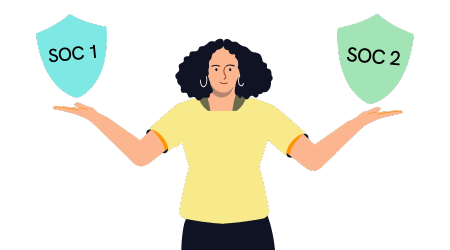Service organizations often undergo SOC (Service Organization Control) attestation to assure clients and stakeholders of the effectiveness of their internal controls. Two prominent frameworks within the SOC domain are SOC 1 and SOC 2, each designed to address specific facets of a service organization’s controls. Read on to learn how to compare SOC 1 vs SOC 2 attestations.
What is a SOC attestation?
SOC attestation refers to the process of obtaining an attestation report from an independent auditor regarding the effectiveness and suitability of a service organization’s internal controls. This process is part of the Service Organization Control (SOC) framework established by the American Institute of Certified Public Accountants (AICPA). There are different types of SOC reports, such as SOC 1 and SOC 2, each tailored to assess specific aspects of a service organization’s controls.
What are SOC Controls or Criteria?
SOC (Service Organization Control) controls or criteria are designed to address specific areas of concern for different types of service organizations. For instance, SOC 1 controls focus on internal controls over financial reporting, while SOC 2 controls encompass a broader set of criteria related to security, availability, processing integrity, confidentiality, and privacy. The controls serve as benchmarks against which service organizations can measure and demonstrate the effectiveness of their processes and safeguards. During a SOC audit, third-party auditors evaluate these controls, providing organizations with a reliable means of assuring clients and stakeholders that their systems and operations meet recognized standards for security, reliability, and integrity.
What is included in SOC 1 vs SOC 2 reports?
A SOC 1 report provides a point-in-time assessment of the design of controls, whereas a SOC 2 report offers a more comprehensive evaluation by assessing both design and operational effectiveness over a specified period.
- SOC 1 Report:
- Scope: A SOC 1 report assesses the suitability of the design of a service organization’s controls at a specific point in time, evaluating whether the controls are appropriately designed to achieve their objectives.
- Duration: The examination is conducted on a specific date, offering a snapshot of the controls’ design effectiveness at that particular moment.
- Focus: SOC 1 reports concentrate more on the description and design of controls than their operational effectiveness over an extended period.
- SOC 2 Report:
- Scope: A SOC 2 report evaluates both the design and operational effectiveness of controls over a specified period, typically a minimum of six months. It provides a more comprehensive view of how well the controls are functioning over time.
- Duration: The examination covers a specific period, allowing for an evaluation of how controls operate over an extended timeframe, including their effectiveness in addressing risks and achieving intended objectives.
- Focus: While a SOC 2 report includes information on the design of controls, its primary emphasis is on their operational effectiveness and how well they mitigate risks throughout the assessment period.
Key Differences between SOC 1 and SOC 2:
Scope of Controls:
SOC 1 focuses on controls relevant to financial reporting, while SOC 2 covers a broader set of controls related to information security.
Trust Service Criteria:
SOC 2 explicitly incorporates the Trust Service Criteria, including security, availability, processing integrity, confidentiality, and privacy. SOC 1 primarily focuses on the controls relevant to financial reporting.
Applicability:
SOC 1 is specifically designed for organizations dealing with financial data, whereas SOC 2 has a wider applicability and is relevant for any service organization managing sensitive information.
Use Case:
The SOC 1 attestation is commonly used by financial and accounting firms, whereas the SOC 2 is more widely used by technology and cloud service providers.
Both SOC 1 and SOC 2 reports are crucial for service organizations to demonstrate their commitment to security, integrity, and confidentiality, providing assurance to clients and stakeholders. Organizations often engage with third-party auditors to assess and validate their controls, culminating in the issuance of these SOC reports.
How do Type 1 and Type 2 reports fit in?
Both SOC 1 and SOC 2 have Type 1 and Type 2 reports, which can be confusing.
- Type 1 (for both SOC 1 and 2) does not require samples in testing.
- Type 2 (for both SOC 1 and 2) requires samples.
How do I choose between SOC 1 and SOC 2 reports?
Choosing between SOC 1 and SOC 2 reports depends on the nature of your business operations, the type of services you provide, and the specific concerns and expectations of your clients and stakeholders. Here are key considerations to help you make an informed decision:
Nature of Services:
-
- SOC 1: If your organization provides services that directly impact the financial reporting of your clients (e.g., payroll processing, financial statement preparation), SOC 1 is likely more relevant. SOC 1 is designed to assess controls related to financial reporting, making it suitable for organizations where the integrity of financial information is a primary concern.
- SOC 2: If your services involve the handling of sensitive information beyond financial data, such as customer data, intellectual property, or personally identifiable information (PII), SOC 2 may be more appropriate. SOC 2 assesses controls related to security, availability, processing integrity, confidentiality, and privacy.
Client Requirements:
Consider the specific requirements of your clients or stakeholders. If they are primarily concerned with the security, availability, and privacy of data, SOC 2 may be more aligned with their expectations. On the other hand, if they are more focused on the impact of your services on their financial reporting, SOC 1 may be the preferred choice.
Industry Standards:
Examine industry standards and regulatory requirements. Some industries may have specific compliance standards that align with SOC 1 or SOC 2. For instance, financial institutions may prioritize SOC 1 compliance, while technology and SaaS companies may lean towards SOC 2.
Risk Management:
Assess the specific risks associated with your business operations. If the risks are primarily related to financial reporting accuracy and compliance, SOC 1 may be more suitable. If the risks extend to data security, privacy, and system availability, SOC 2 provides a broader framework for evaluation.
Scope of Controls:
Consider the scope of controls you want to assess. SOC 1 focuses on controls relevant to financial reporting, while SOC 2 covers a broader set of criteria, including security, availability, processing integrity, confidentiality, and privacy.
Client Trust and Assurance:
If your clients are looking for assurance beyond financial controls and are concerned about the overall security and reliability of your services, having a SOC 2 report can provide them with a more comprehensive view of your organization’s controls.
In some cases, organizations may choose to pursue both SOC 1 and SOC 2 reports if their services involve aspects covered by both frameworks. Ultimately, the decision should align with your organizational objectives, client expectations, and the specific risks associated with your business operations. Consulting with clients, stakeholders, and compliance experts can also provide valuable insights in making an informed decision.


